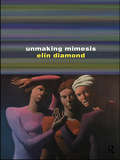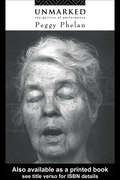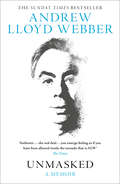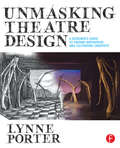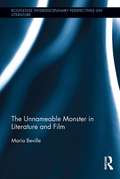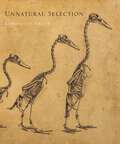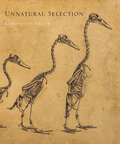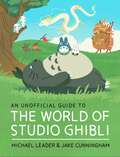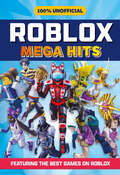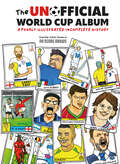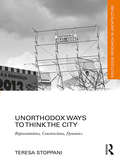- Table View
- List View
Unmaking Mimesis: Essays on Feminism and Theatre
by Elin DiamondIn Unmaking Mimesis Elin Diamond interrogates the concept of mimesis in relation to feminism, theatre and performance. She combines psychoanalytic, semiotic and materialist strategies with readings of selected plays by writers as diverse as Ibsen, Brecht, Aphra Behn, Caryl Churchill and Peggy Shaw. Through a series of provocative readings of theatre, theory and feminist performance she demonstrates the continuing force of feminism and mimesis in critical thinking today. Unmaking Mimesis will interest theatre scholars and performance and cultural theorists, for all of whom issues of text, representation and embodiment are of compelling concern.
Unmaking Mimesis: Essays on Feminism and Theatre
by Elin DiamondIn Unmaking Mimesis Elin Diamond interrogates the concept of mimesis in relation to feminism, theatre and performance. She combines psychoanalytic, semiotic and materialist strategies with readings of selected plays by writers as diverse as Ibsen, Brecht, Aphra Behn, Caryl Churchill and Peggy Shaw. Through a series of provocative readings of theatre, theory and feminist performance she demonstrates the continuing force of feminism and mimesis in critical thinking today. Unmaking Mimesis will interest theatre scholars and performance and cultural theorists, for all of whom issues of text, representation and embodiment are of compelling concern.
Unmarked: The Politics of Performance
by Peggy PhelanUnmarked is a controversial analysis of the fraught relation between political and representational visibility in contemporary culture. Written from and for the Left, Unmarked rethinks the claims of visibility politics through a feminist psychoanalytic examination of specific performance texts - including photography, painting, film, theatre and anti-abortion demonstrations.
Unmarked: The Politics of Performance
by Peggy PhelanUnmarked is a controversial analysis of the fraught relation between political and representational visibility in contemporary culture. Written from and for the Left, Unmarked rethinks the claims of visibility politics through a feminist psychoanalytic examination of specific performance texts - including photography, painting, film, theatre and anti-abortion demonstrations.
Unmasked: A Memoir
by Andrew Lloyd Webber“You have the luck of Croesus on stilts (as my Auntie Vi would have said) if you’ve had the sort of career, ups and downs, warts and all that I have in that wondrous little corner of show business called musical theatre.”
Unmasking Theatre Design: A Designer's Guide To Finding Inspiration And Cultivating Creativity
by Lynne PorterEvery great design has its beginnings in a great idea, whether your medium of choice is scenery, costume, lighting, sound, or projections. Unmasking Theatre Design shows you how to cultivate creative thinking skills through every step of theatre design - from the first play reading to the finished design presentation. This book reveals how creative designers think in order to create unique and appropriate works for individual productions, and will teach you how to comprehend the nature of the design task at hand, gather inspiration, generate potential ideas for a new design, and develop a finished look through renderings and models. The exercises presented in this book demystify the design process by providing you with specific actions that will help you get on track toward fully-formed designs. Revealing the inner workings of the design process, both theoretically and practically, Unmasking Theatre Design will jumpstart the creative processes of designers at all levels, from student to professionals, as you construct new production designs.
Unmasking Theatre Design: A Designer's Guide To Finding Inspiration And Cultivating Creativity
by Lynne PorterEvery great design has its beginnings in a great idea, whether your medium of choice is scenery, costume, lighting, sound, or projections. Unmasking Theatre Design shows you how to cultivate creative thinking skills through every step of theatre design - from the first play reading to the finished design presentation. This book reveals how creative designers think in order to create unique and appropriate works for individual productions, and will teach you how to comprehend the nature of the design task at hand, gather inspiration, generate potential ideas for a new design, and develop a finished look through renderings and models. The exercises presented in this book demystify the design process by providing you with specific actions that will help you get on track toward fully-formed designs. Revealing the inner workings of the design process, both theoretically and practically, Unmasking Theatre Design will jumpstart the creative processes of designers at all levels, from student to professionals, as you construct new production designs.
Unmögliche Wirklichkeiten: Ikonische Differenz und digitaler Zweifel in fotokünstlerischen Bildern der Gegenwart (Image #238)
by Laura BreedeFotografische Bilder stehen seit jeher im Spannungsverhältnis zwischen Evidenz und Konstruktion. Insbesondere die zunehmend komplexer werdenden Möglichkeiten fotografischer Bildproduktion im digitalen Raum stellen einen vermeintlichen Realitätsbezug in Frage. Basierend auf einer Diskursanalyse philosophischer sowie bild- und medientheoretischer Bildwahrnehmungskonzepte entwirft Laura Breede ein Analyseinstrumentarium, um fotografische Phänomene der Gegenwart im Schwellenbereich zwischen Fiktion und Dokumentation zu fassen. Fotokünstlerische Arbeiten von Andreas Gefeller, Thomas Demand, Andreas Gursky und Michael Reisch lassen sich damit als Unmögliche Wirklichkeiten kategorisieren.
The Unnameable Monster in Literature and Film (Routledge Interdisciplinary Perspectives on Literature)
by Maria BevilleThis book visits the 'Thing' in its various manifestations as an unnameable monster in literature and film, reinforcing the idea that the very essence of the monster is its excess and its indeterminacy. Tied primarily to the artistic modes of the gothic, science fiction, and horror, the unnameable monster retains a persistent presence in literary forms as a reminder of the sublime object that exceeds our worst fears. Beville examines various representations of this elusive monster and argues that we must looks at the monster, rather than through it, at ourselves. As such, this book responds to the obsessive manner in which the monsters of literature and culture are ‘managed’ in processes of classification and in claims that they serve a social function by embodying all that is horrible in the human imagination. The book primarily considers literature from the Romantic period to the present, and film that leans toward postmodernism. Incorporating disciplines such as cultural theory, film theory, literary criticism, and continental philosophy, it focuses on that most difficult but interesting quality of the monster, its unnameability, in order to transform and accelerate current readings of not only the monsters of literature and film, but also those that are the focus of contemporary theoretical discussion.
The Unnameable Monster in Literature and Film (Routledge Interdisciplinary Perspectives on Literature)
by Maria BevilleThis book visits the 'Thing' in its various manifestations as an unnameable monster in literature and film, reinforcing the idea that the very essence of the monster is its excess and its indeterminacy. Tied primarily to the artistic modes of the gothic, science fiction, and horror, the unnameable monster retains a persistent presence in literary forms as a reminder of the sublime object that exceeds our worst fears. Beville examines various representations of this elusive monster and argues that we must looks at the monster, rather than through it, at ourselves. As such, this book responds to the obsessive manner in which the monsters of literature and culture are ‘managed’ in processes of classification and in claims that they serve a social function by embodying all that is horrible in the human imagination. The book primarily considers literature from the Romantic period to the present, and film that leans toward postmodernism. Incorporating disciplines such as cultural theory, film theory, literary criticism, and continental philosophy, it focuses on that most difficult but interesting quality of the monster, its unnameability, in order to transform and accelerate current readings of not only the monsters of literature and film, but also those that are the focus of contemporary theoretical discussion.
The Unnaming of Aliass
by Karin BolenderThe Unnaming of Aliass performs a paradoxical quest for wildly “untold” stories in the company of one special donkey companion, a femammal of the species Equus asinus and, significantly, a registered “American Spotted Ass.” Beast of burden that she is, this inscrutable companion helped carry a ridiculous load of human longings and quandaries into a maze of hot, harrowing miles, across the US South from Mississippi to Virginia, in the summer of 2002 -- all the while carrying her own onerous and unreckoned burdens and histories. Over two decades, the original journey evolved -- from the cracking-open of a quasi-Western novel-that-never-was by an implosive pun, into an ongoing philosophical and assthetic adventure: a hybrid roadside- and barnyard-based living-art practice, wherein “Aliass” un/names something much harder to grasp than the body of a lovely little ass: protagonist, setting, and traditional Western narratives turn inside-out around this “name-that-ain’t.” Through a deeply dug-in questioning of its own authorial assumptions, The Unnaming of Aliass makes space for untold autobiographies and bright dusty lacunae, tracing ineffable tales through the tangled shapes and shadows that interweave in any environment.
Unnatural Selection
by Katrina Van GrouwA lavishly illustrated look at how evolution plays out in selective breedingUnnatural Selection is a stunningly illustrated book about selective breeding--the ongoing transformation of animals at the hand of man. More important, it's a book about selective breeding on a far, far grander scale—a scale that encompasses all life on Earth. We'd call it evolution.A unique fusion of art, science, and history, this book celebrates the 150th anniversary of Charles Darwin's monumental work The Variation of Animals and Plants under Domestication, and is intended as a tribute to what Darwin might have achieved had he possessed that elusive missing piece to the evolutionary puzzle—the knowledge of how individual traits are passed from one generation to the next. With the benefit of a century and a half of hindsight, Katrina van Grouw explains evolution by building on the analogy that Darwin himself used—comparing the selective breeding process with natural selection in the wild, and, like Darwin, featuring a multitude of fascinating examples.This is more than just a book about pets and livestock, however. The revelation of Unnatural Selection is that identical traits can occur in all animals, wild and domesticated, and both are governed by the same evolutionary principles. As van Grouw shows, animals are plastic things, constantly changing. In wild animals the changes are usually too slow to see—species appear to stay the same. When it comes to domesticated animals, however, change happens fast, making them the perfect model of evolution in action. Suitable for the lay reader and student, as well as the more seasoned biologist, and featuring more than four hundred breathtaking illustrations of living animals, skeletons, and historical specimens, Unnatural Selection will be enjoyed by anyone with an interest in natural history and the history of evolutionary thinking.
Unnatural Selection (PDF) (400MB+)
by Katrina Van GrouwUnnatural Selection is a stunningly illustrated book about selective breeding--the ongoing transformation of animals at the hand of man. More important, it's a book about selective breeding on a far, far grander scale—a scale that encompasses all life on Earth. We'd call it evolution. A unique fusion of art, science, and history, this book celebrates the 150th anniversary of Charles Darwin's monumental work The Variation of Animals and Plants under Domestication, and is intended as a tribute to what Darwin might have achieved had he possessed that elusive missing piece to the evolutionary puzzle—the knowledge of how individual traits are passed from one generation to the next. With the benefit of a century and a half of hindsight, Katrina van Grouw explains evolution by building on the analogy that Darwin himself used—comparing the selective breeding process with natural selection in the wild, and, like Darwin, featuring a multitude of fascinating examples. This is more than just a book about pets and livestock, however. The revelation of Unnatural Selection is that identical traits can occur in all animals, wild and domesticated, and both are governed by the same evolutionary principles. As van Grouw shows, animals are plastic things, constantly changing. In wild animals the changes are usually too slow to see—species appear to stay the same. When it comes to domesticated animals, however, change happens fast, making them the perfect model of evolution in action. Suitable for the lay reader and student, as well as the more seasoned biologist, and featuring more than four hundred breathtaking illustrations of living animals, skeletons, and historical specimens, Unnatural Selection will be enjoyed by anyone with an interest in natural history and the history of evolutionary thinking. Katrina van Grouw, author of The Unfeathered Bird (Princeton), inhabits that no-man's-land midway between art and science. She holds degrees in fine art and natural history illustration and is a former curator of ornithological collections at a major national museum. She's a self-taught scientist with a passion for evolutionary biology and its history.
An Unofficial Guide to the World of Studio Ghibli
by Michael Leader Jake CunninghamFrom the creators of the podcast and bestselling book Ghibliotheque, this is a young film fan's comprehensive guide to one of the most exciting and influential film studios in cinema history, creators of beloved classics ranging from Spirited Away and My Neighbour Totoro to Ponyo and Kiki's Delivery Service.Across eight chapters, we will get up close and personal with the movies, learn who's who at the Oscar-winning studio and explore the impact that Ghibli World has left on our planet.
The Unofficial LEGO® Jewellery Book: 18 awesome designs for fashion accessories from LEGO® bricks
by Prudence RogersEveryone loves LEGO®! This bright collection of 18 jewellery and fashion accessory projects will show you that LEGO® is not just for model making and can be used to create unique and quirky wearables that will be the talk of the town. With ideas ranging from necklaces, rings and bracelets to brooches, belt buckles and even hairbands, readers will be wowed by the creative possibilities of LEGO® as a crafting medium. All the tools, equipment and techniques are explained, and detailed step-by-step instructions will show you what components you need and how to build up each design. Fashion themes included range from Gothic to Kitsch, Nature to Urban and include designs that readers both young and young-at-heart will admire and adore.
The Unofficial LEGO® Jewelry Book: 18 awesome designs for fashion accessories from LEGO® bricks
by Prudence RogersEveryone loves LEGO®! This bright collection of 18 jewellery and fashion accessory projects will show you that LEGO® is not just for model making and can be used to create unique and quirky wearables that will be the talk of the town. With ideas ranging from necklaces, rings and bracelets to brooches, belt buckles and even hairbands, readers will be wowed by the creative possibilities of LEGO® as a crafting medium. All the tools, equipment and techniques are explained, and detailed step-by-step instructions will show you what components you need and how to build up each design. Fashion themes included range from Gothic to Kitsch, Nature to Urban and include designs that readers both young and young-at-heart will admire and adore.
The Unofficial LEGO® Jewelry Book: 18 awesome designs for fashion accessories from LEGO® bricks
by Prudence RogersEveryone loves LEGO®! This bright collection of 18 jewellery and fashion accessory projects will show you that LEGO® is not just for model making and can be used to create unique and quirky wearables that will be the talk of the town. With ideas ranging from necklaces, rings and bracelets to brooches, belt buckles and even hairbands, readers will be wowed by the creative possibilities of LEGO® as a crafting medium. All the tools, equipment and techniques are explained, and detailed step-by-step instructions will show you what components you need and how to build up each design. Fashion themes included range from Gothic to Kitsch, Nature to Urban and include designs that readers both young and young-at-heart will admire and adore.
The Unofficial World Cup Album: A Poorly Illustrated Incomplete History
by No Score DrawsThe greatest moments in sporting history in inglorious technicolour, from the ‘artists’ known as NO SCORE DRAWS ‘Genuinely upsetting.’ David Squires ‘Repulsively ugly.’ Séamas O'Reilly
Unorthodox Ways to Think the City: Representations, Constructions, Dynamics (Routledge Research in Architecture)
by Teresa StoppaniThis book argues that architecture and the city and their processes can be better understood by drawing categories from disciplines that exceed the architectural and urban cultural context. It performs an open intellectual reading that traverses architecture and architectural theory, but also art theory and history, cartography, philosophy, literature and cultural studies, to unfold a series of ‘figures’ that are ambiguously placed between the representation and the construction of space in architecture and the city. The paradigm and philosophy, the island and the city, the map and representation, the model and making and the questioning of form performed by dust, are explored beyond their definition, as processes that differently make space between architecture and the city and are proposed as unorthodox analytic techniques to decipher contemporary spatial complexity. The book analyses how these ‘figures’ have been employed at different times and in different creative disciplines, beyond architecture and in relation to changing notions of space, and traces the role that they have played in the shift towards the dynamic that has taken place in contemporary theory and design research. What emerges is the idea of an ‘architecture of the city’ that is not only physical but is largely defined by the way in which its physical spaces are regulated, lived and perceived, but also imagined and projected.
Unorthodox Ways to Think the City: Representations, Constructions, Dynamics (Routledge Research in Architecture)
by Teresa StoppaniThis book argues that architecture and the city and their processes can be better understood by drawing categories from disciplines that exceed the architectural and urban cultural context. It performs an open intellectual reading that traverses architecture and architectural theory, but also art theory and history, cartography, philosophy, literature and cultural studies, to unfold a series of ‘figures’ that are ambiguously placed between the representation and the construction of space in architecture and the city. The paradigm and philosophy, the island and the city, the map and representation, the model and making and the questioning of form performed by dust, are explored beyond their definition, as processes that differently make space between architecture and the city and are proposed as unorthodox analytic techniques to decipher contemporary spatial complexity. The book analyses how these ‘figures’ have been employed at different times and in different creative disciplines, beyond architecture and in relation to changing notions of space, and traces the role that they have played in the shift towards the dynamic that has taken place in contemporary theory and design research. What emerges is the idea of an ‘architecture of the city’ that is not only physical but is largely defined by the way in which its physical spaces are regulated, lived and perceived, but also imagined and projected.
Unpacking international organisations: The dynamics of compound bureaucracies (European Policy Research Unit)
by Jarle Trondal Martin Marcussen Torbjorn Larsson Frode VeggelandThis book introduces international bureaucracy as a key field of study for public administration and also rediscovers it as an essential ingredient in the study of international organisations. To what extent, how and why do international bureaucracies challenge and supplement the inherent Westphalian intergovernmental order based on territorial sovereignty? To what extent, how and why do international bureaucracies supplement the existing international intergovernmental order with a multi-dimensional international order subjugated by a compound set of decision-making dynamics? International bureaucracies constitute a distinct and increasingly important feature of public administration studies. However, the role of international bureaucracies has been largely neglected in most social science sub-disciplines. This book takes a first step into a third generation of international organisation (IO) studies. It will be of immense value to academics in politics and international relations as well as practitioners in public administration in domestic governments and international organizations.
Unplugging Popular Culture: Reconsidering Analog Technology, Materiality, and the “Digital Native" (Routledge Research in Cultural and Media Studies)
by K. Shannon HowardUnplugging Popular Culture showcases youth and young adult characters from film and television who defy the stereotype of the "digital native" who acts as an unquestioning devotee to screened technologies like the smartphone. In this study, unplugged tools, or non-digital tools, do not necessitate a ban on technology or a refusal to acknowledge its affordances but work instead to highlight the ability of fictional characters to move from high tech settings to low tech ones. By repurposing everyday materials, characters model the process of reusing and upcycling existing materials in innovative ways. In studying examples such as Pitch Perfect, Supernatural, Stranger Things, and Get Out, the book aims to make theories surrounding materiality apparent within popular culture and to help today’s readers reconsider stereotypes of the young people they encounter on a daily basis.
Unplugging Popular Culture: Reconsidering Analog Technology, Materiality, and the “Digital Native" (Routledge Research in Cultural and Media Studies)
by K. Shannon HowardUnplugging Popular Culture showcases youth and young adult characters from film and television who defy the stereotype of the "digital native" who acts as an unquestioning devotee to screened technologies like the smartphone. In this study, unplugged tools, or non-digital tools, do not necessitate a ban on technology or a refusal to acknowledge its affordances but work instead to highlight the ability of fictional characters to move from high tech settings to low tech ones. By repurposing everyday materials, characters model the process of reusing and upcycling existing materials in innovative ways. In studying examples such as Pitch Perfect, Supernatural, Stranger Things, and Get Out, the book aims to make theories surrounding materiality apparent within popular culture and to help today’s readers reconsider stereotypes of the young people they encounter on a daily basis.
Unplugging the City: The Urban Phenomenon and its Sociotechnical Controversies
by Fábio Duarte Rodrigo Jose FirminoModernity has entrusted technology with such power that it is treated as an autonomous entity, with its own manners and morals. Technological disruptions are also socially disruptive: technological failures reveal both the constituents of the technology itself and the social fabric woven by this technology. Cities are the quintessential technological arrangement, not only materially but also as a conceptual framework: the ubiquity of technology makes us think and plan cities mostly in terms of technological arrangements. Unplugging the City: The Urban Phenomenon and its Sociotechnical Controversies proposes a conceptual and methodological framework for analyzing certain urban phenomena as a technological assemblage. It demonstrates, through multiple case studies, the sociotechnical complexities involved in the stabilization and disruption of urban technological arrangements. Examples range from the urban phantasmagorias portrayed in science-fiction movies to the urban proposals of Brasilia and Masdar, from the book of bike-sharing systems to pervasive global surveillance systems. Written by Fábio Duarte and Rodrigo Firmino, based on their original research and publications, this is an essential resource for those interested in the theory and study of technology and its inextricable influence on the city.
